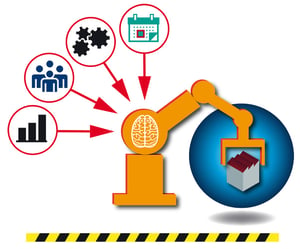5 More Industry 4.0 Stats to Know in 2021
Brian Hoey - March 28, 2019

 By now, most of you know that Industry 4.0 revolves largely around the creation of cyber-physical systems. This can take many forms, from simulation-ready digital twins of your factory floor operations to advanced alert systems integrated with IIoT (industrial internet of things) devices. What some of you may still be wondering about is how, exactly, these things are going to add value. What is it about cyber-physical systems that will make life easier, or more efficient, or more profitable for modern manufacturers? When all is said and done, what will industrial operations in the Industry 4.0 era look like? Hopefully, these five statistics can shed some light on all of these questions.
By now, most of you know that Industry 4.0 revolves largely around the creation of cyber-physical systems. This can take many forms, from simulation-ready digital twins of your factory floor operations to advanced alert systems integrated with IIoT (industrial internet of things) devices. What some of you may still be wondering about is how, exactly, these things are going to add value. What is it about cyber-physical systems that will make life easier, or more efficient, or more profitable for modern manufacturers? When all is said and done, what will industrial operations in the Industry 4.0 era look like? Hopefully, these five statistics can shed some light on all of these questions.
$7.1 Trillion
How much value IIoT adoption could add to the US GDP by 2030. For Germany, that number is $700 billion. For China, it’s $1.8 trillion. This represents a huge source of latent value for the industrial sectors in these countries and around the world. But where exactly does that value come from? For our purposes, we might think of the IIoT as being a symbol of Industry 4.0 processes more broadly—after all, they contribute to the creation of exactly the sorts of cyber-physical system we discussed above. In this way, we can see how increased technology adoption in this field could promote smarter factories, which would in turn lead to more efficient planning and production flows, increased order customization, and ultimately a more successful anticipation of future customer demands, all powered by data-driven decision-making.
12% Gains in Efficiency
What German companies investing in digital factories expect as a result of IIoT adoption in the next five years. Here, we start to get a sense of one of the ways that these new industrial paradigms will create value. If you’re able to gain a comprehensive, real-time view of your production flows based on the data streams that these devices produce, you can, for example, take a proactive approach to reducing downtime. You can monitor early warning signs of machine breakdowns and use those signs to determine optimal times for machine maintenance, thereby reducing unplanned downtime. By the same token, your data streams could be used to predict the effects of any proposed process changes, meaning that you could avoid making any adjustments to your production processes that would result in lost efficiency or value.
9 out of 10
The number of survey respondents in the German industrial space who believed that digitization offered more opportunities than risks. Obviously, we’re not the only ones who have noticed the tremendous potential that Industry 4.0 systems have for modern manufacturing. To wit, most businesses see digitization as a winning proposition rife with potential value-adds. This hasn’t necessarily been the case in the past. Companies with a fear of disrupting their own internal processes might have shied away from digitization within the recent past; they might have also cited concerns over access control, security, and the possibility of malfunctions. As we get deeper into the digital era, those concerns are taking a backseat to all of the ways that digitization can improve efficiency, create visibility, and provide opportunities for integration.
Half as Important
The expectation for the relative importance of spreadsheets five years from the time of the survey (2016), a decrease from 54% to 27%. This is music to our ears—to say nothing of being a symbol of improvements in digital integration industry-wide. Spreadsheets, by nature, are not especially visible. If, for example, you’re performing production planning workflows in an Excel spreadsheet, it’s a virtual guarantee that most key stakeholders outside of the immediate production planning team won’t have access to the information that it contains. This means that if a transport planner were trying to schedule a shipment of goods from the production line to a warehouse, she’d have no way of knowing how much freight capacity to reserve, to say nothing of the optimal moment for transporting the goods. This kind of disconnect and siloization can find different teams working at cross-purposes, ultimately leading to disruptions and shutdowns that could have been avoided in more high-visibility environments. Beyond that, an Excel spreadsheet has no way of connecting automatically with other data streams, meaning that as production conditions change and evolve there’s no guarantee that actual production plans will evolve with them. Thus, it’s extremely heartening from the prospective of Industry 4.0 adoption to see the spreadsheet waning in importance and (hopefully) being replaced with open, connected software environments that promote data and planning visibility intra-operationally.
More than Quadruple
The number of industrial leaders who believe that data analytics will be crucial to decision making in the next five, compared to the number who believe in its importance for present-day business success. Looking towards the future, the importance of the data being collected right now by IIoT devices and other digital infrastructure will only become more important. Even as we speak, advanced prescriptive and predictive analytics algorithms are available to manufacturers that can help them to improve demand forecasts and uncover areas of waste and inefficiency. Within the tremendous caches of data that are produced on a daily basis by these kinds of outfits, there are potential sources of value waiting to be uncovered. Businesses are variously using this data to estimate future customer demand levels in order to more effective map out their ongoing capacity usage; they’re using it to organize their transport networks in more efficient ways; they’re using it to schedule production in job shop environments that would otherwise be virtually impossible to optimize; and they’re using it to better integrate their IT environments with those of their suppliers and other partners in order to create synergy and promote visibility. Right now, each of these applications offers a distinct competitive advantage. But, if the above statistic is any indication, within the next few years these advanced analytics processes will be a necessity, rather than a luxury. In that scenario, the winners will be those who jumped on the digitization bandwagon relatively early on.
LATEST POSTS
- Understand Circular Economy in The Manufacturing Industry
- How Can Industry 4.0 IT Integration Be Achieved Smoothly?
- The Significance of Order Sequencing in Discrete Manufacturing
- How to improve your Supply Chain Management: The Power of Control Towers
- Optimizing Human Resource Scheduling in Manufacturing: A Technological Approach



